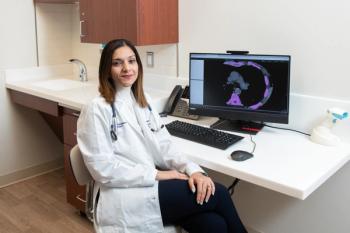
Migrated Intracranial Aneurysm Clip
A 53-year-old woman had complained of pain in the lower right quadrant of her abdomen for 1 year. She claimed that the pain intensified when she bent forward in a particular position but believed it was unrelated to food, bowel movements, or urination. There was no weight loss, vomiting, or melena. There was no family history of colon cancer or inflammatory bowel disease.
A 53-year-old woman had complained of pain in the lower right quadrant of her abdomen for 1 year. She claimed that the pain intensified when she bent forward in a particular position but believed it was unrelated to food, bowel movements, or urination. There was no weight loss, vomiting, or melena. There was no family history of colon cancer or inflammatory bowel disease.
Four years before presenting for the abdominal pain, this woman underwent surgery for a subarachnoid hemorrhage. A right superior cerebellar artery aneurysm and a right internal carotid bifurcation aneurysm were clipped.
Examination of the abdomen revealed mild, right lower quadrant tenderness without guarding or rigidity. A stool specimen was guaiac-negative. Results of the neurologic evaluation were unremarkable. Complete blood cell count and liver and kidney function laboratory findings were normal.
The woman's abdominal pain was thought to have a musculoskeletal cause, and NSAIDs were prescribed. At the 1-month follow-up examination, the patient's pain and physical findings remained unchanged. A barium enema was ordered; the results were normal.
Dr Gerald Muthu of Casa Grande, Ariz, writes that the radiographic evaluation revealed that only the right internal carotid bifurcation aneurysm clip remained in the skull (A). Films of the lumbar spine showed a metallic clip in the lumbosacral interspace (B and C).
The right superior cerebellar artery aneurysm clip had migrated down the epidural space and lodged in the cauda equina, possibly causing the pain. Dr Muthu notes that the patient is scheduled for a cerebral angiogram and subsequent surgery to remove the clip in the spine.
Newsletter
Enhance your clinical practice with the Patient Care newsletter, offering the latest evidence-based guidelines, diagnostic insights, and treatment strategies for primary care physicians.























































































































































































































































































